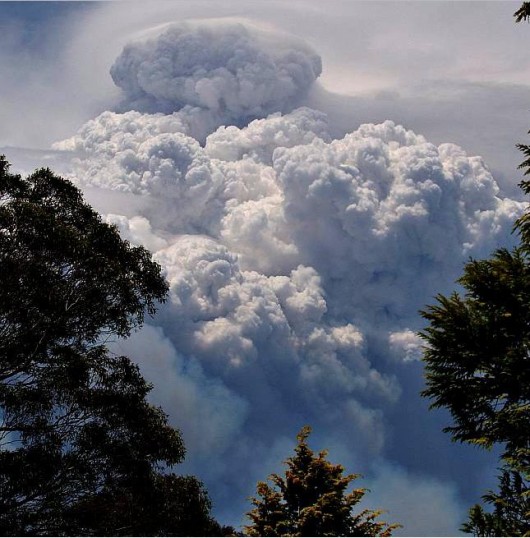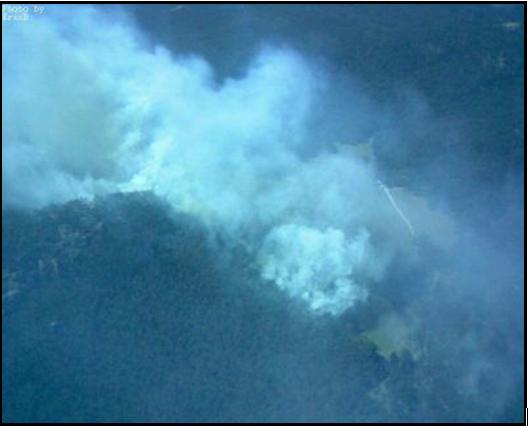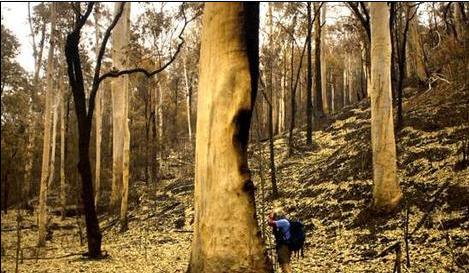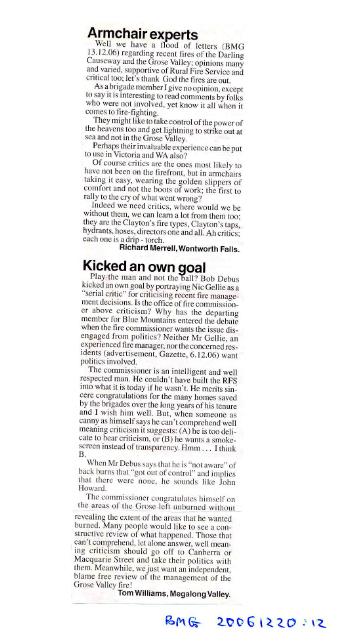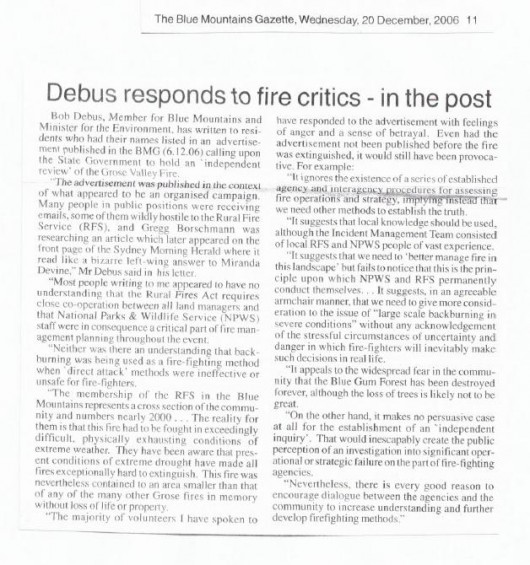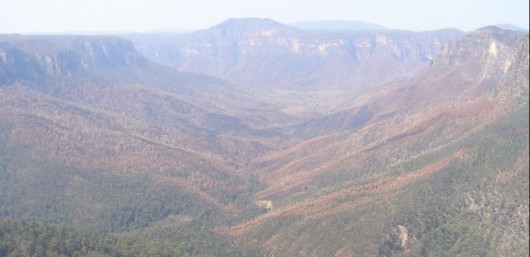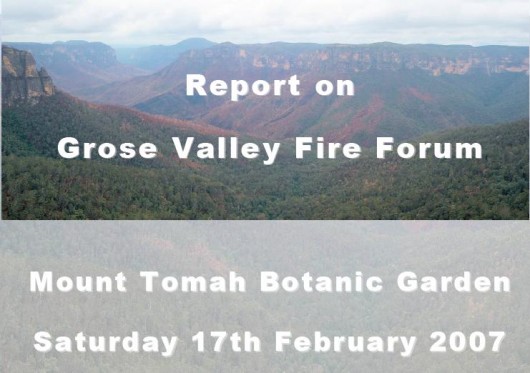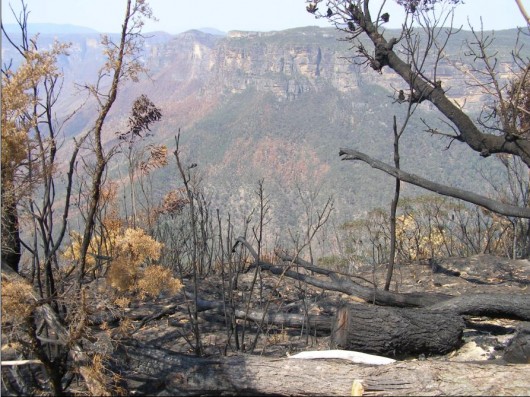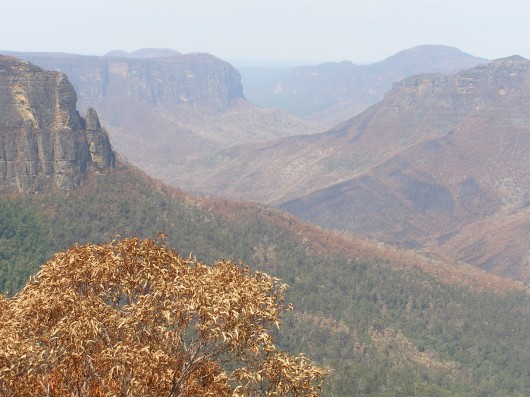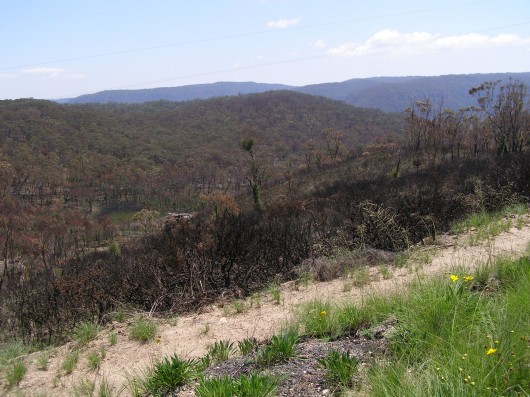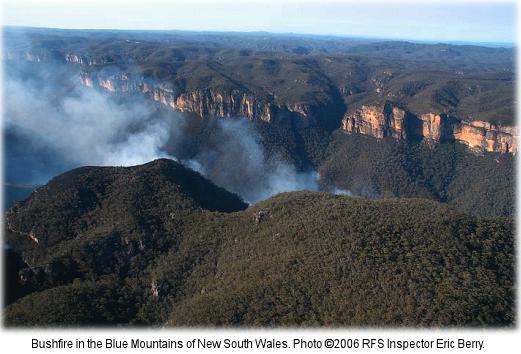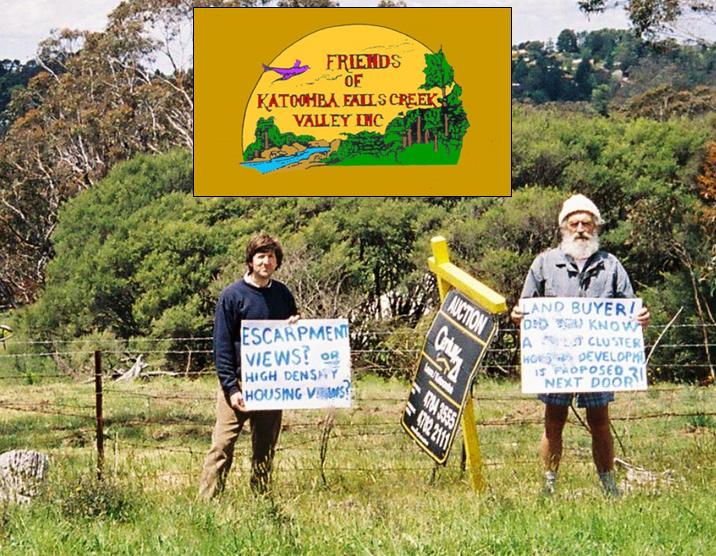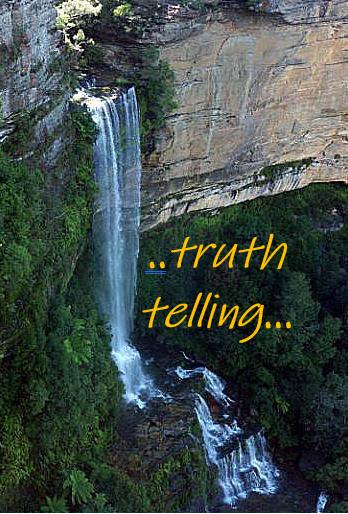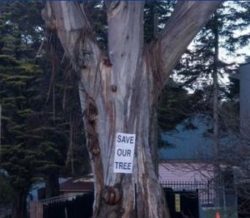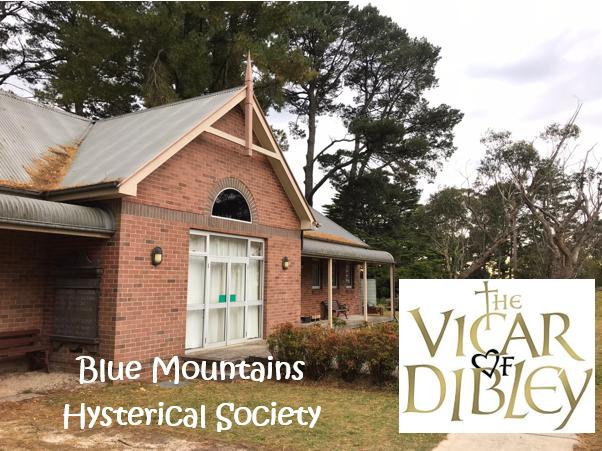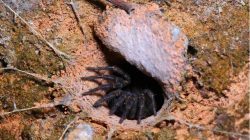Rural Fire Service strategy misguided
Friday, March 30th, 2012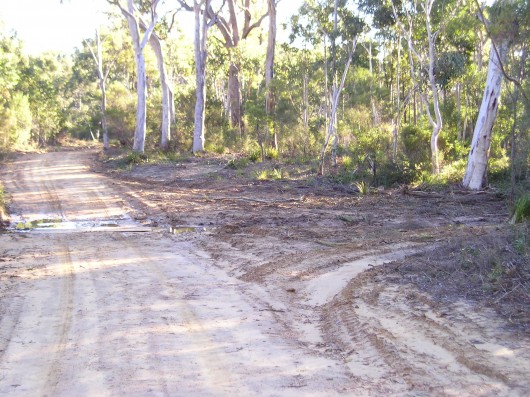 19th Century heritage-listed ‘Six Foot Track’
..bulldozed by the Rural Fire Service in July 2005, widened into a convenient Fire Trail for its fire truck crews.
19th Century heritage-listed ‘Six Foot Track’
..bulldozed by the Rural Fire Service in July 2005, widened into a convenient Fire Trail for its fire truck crews.
.
It has been revealed that the June bulldozing or grading of the Six Foot Track near Megalong Creek (Blue Mountains, New South Wales) was a mere drop in the Rural Fire Service (RFS) Bushfire Mitigation Programme.
Across the Blue Mountains, some twenty natural reserves including the Six Foot Track were targeted under the RFS 2004-05 Fire Trail Strategy:
- Edith Falls
- McMahons Point
- Back Creek
- Cripple Creek
- Plus some 95 hectares inside the Blue Mountains National Park.
.
Read: [>RFS Fire Trail Policy]
Read: [>RFS Fire Trail Classification Guidelines]
.
According to the Australian Government’s (then) Department of Transport and Regional Services (DOTARS) website, some $151,195 was granted to the RFS in the Blue Mountains alone, for it to bulldoze and burn 144 hectares of native bushland under the euphemism of “addressing bushfire mitigation risk priorities” (Ed: Read ‘bush arson‘)
‘The Six Foot Track Conservation and Management Plan 1997, Vol II’ lists numerous vulnerable species of fauna recorded near Megalong Creek – the Glossy Black-Cockatoo (Clyptorhynchus lathami), Giant Burrowing Frog (Heleioporus australiacus), Spotted-tailed Quoll (Dasyurus maculatus).
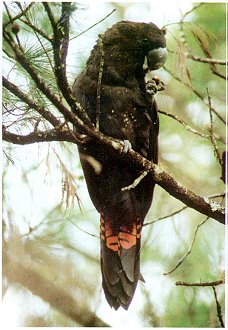 Glossy Black-Cockatoo
[Source: Dubbo Field Naturalist & Conservation Society
Glossy Black-Cockatoo
[Source: Dubbo Field Naturalist & Conservation Societyhttp://www.speednet.com.au/~abarca/black-cockatoo.htm]
.
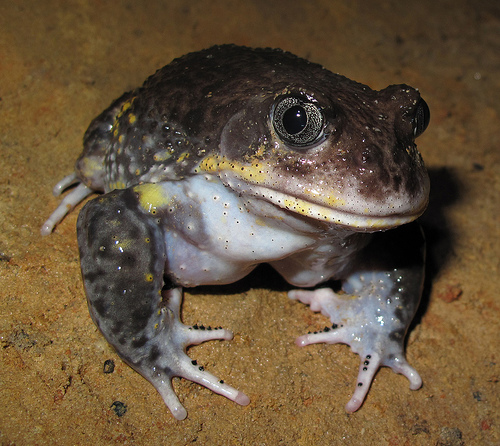 Giant Burrowing Frog
[Source: Frogs.org.au, ^http://frogs.org.au/community/viewtopic.php?t=4876&sid=0dc45ef08e12cd5e1d27524bca2269f9]
Giant Burrowing Frog
[Source: Frogs.org.au, ^http://frogs.org.au/community/viewtopic.php?t=4876&sid=0dc45ef08e12cd5e1d27524bca2269f9]
.
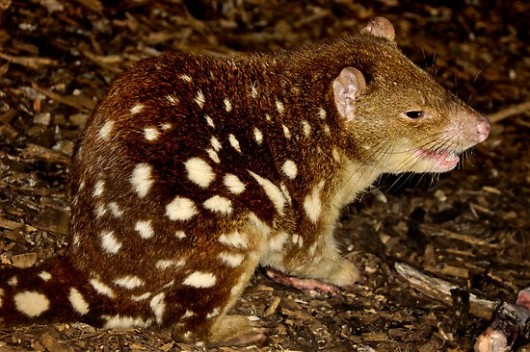 Spotted-tailed Quoll
(Dasyurus maculatus)
Blue Mountains top order predator, competing with the Dingo
Spotted-tailed Quoll
(Dasyurus maculatus)
Blue Mountains top order predator, competing with the Dingo
.
The RFS contractors wouldn’t have had a clue if they were within 100 metres or 1 metre of rare, vulnerable or threatened species.
The RFS is not exempt from destroying important ecological habitat; rather it is required to have regard to the principles of Ecologically Sustainable Development (ESD).
Read: >RFS Policy 2-03 Ecologically Sustainable Development
.
The ‘Rationale‘ of this RFS ESD policy states at Clause 1.2:
‘The Bush Fire Coordinating Committee, under the Rural Fires Act 1997 Sec 3 (d), is required to have regard to ESD as outlined in the Protection of the Environment Administration Act 1991, which sets out the following principles:
a) The precautionary principle namely, that if there are threats of serious or irreversible environmental damage, lack of full scientific certainty should not be used as a reason for postponing measures to prevent environmental degradation. In the application of the precautionary principle, public and private decisions should be guided by:
i. careful evaluation to avoid, wherever practicable, serious or irreversible damage to the environment, and
ii. an assessment of the risk-weighted consequences of various options.
.
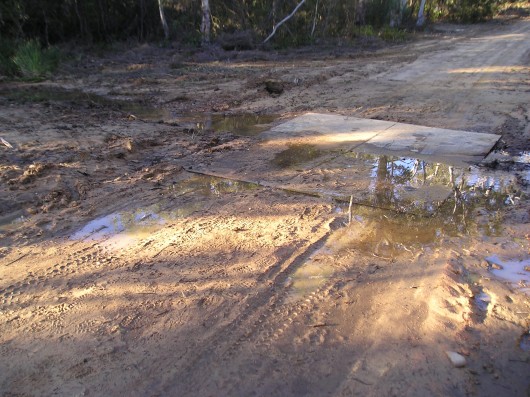
b) Inter-generational equity namely, that the present generation should ensure that the health, diversity and productivity of the environment are maintained or enhanced for the benefit of future generations
.
.
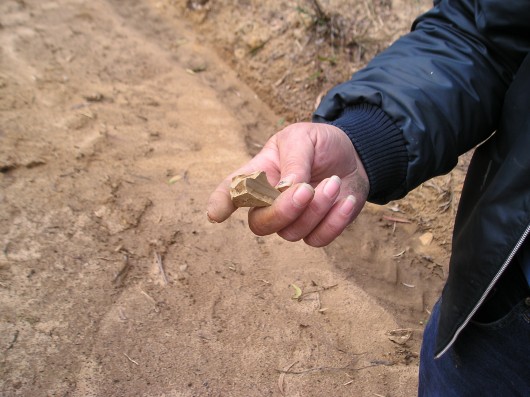
c) Conservation of biological diversity and ecological integrity should be a fundamental consideration in all decisions.
.
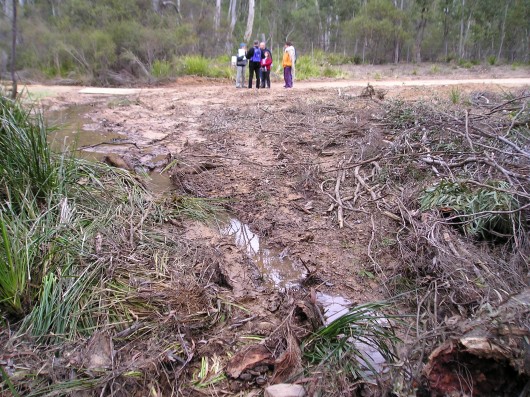
d) Recognising the economic values that the natural environment provides. The natural environment has values that are often hard to quantify but provide a benefit to the entire community. By recognising that the natural environment does have significant economic and social values we can improve decision making for the present and future generations.’
.
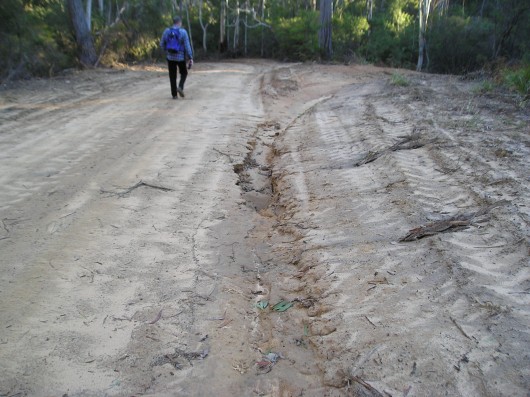 .
.
Yet the RFS policy on hazard reduction is woefully loose in the ‘Bushfire Co-ordinating Committee Policy 2 /03 on ESD‘ – which (on paper) advocates protecting environmental values and ensuring that ESD commitments are adopted and adhered to by contractors.
Experience now confirms this policy is nothing more than ‘greenwashing’. The RFS wouldn’t know what environmental values were if they drove their fire truck into a Blkue Mountains upland swamp. There is not one ecologist among them.
While the critical value of dedicated RFS volunteer fire-fighters fighting fires is without question, what deserves questioning is the unsustainable response of the RFS ‘old guard’ to fire trails and hazard reduction with token regard for sensitive habitat. Repeated bushfire research confirms that bushfires are mostly now caused by:
- Bush arson (hazard reduction included, escaped or otherwise)
- More residential communities encroaching upon bushland.
.
Under the ‘Blue Mountains Bushfire Management Committee Bushfire Risk Management Plan’ (Ed: their bureaucratic name), key objectives are patently ignored:
- ‘Ensure that public and private land owners and occupiers understand their bushfire management responsibilities’
- ‘Ensure that the community is well informed about bushfire protection measures and prepared for bushfire events through Community Fireguard programs’
- ‘Manage bushfires for the protection and conservation of the natural, cultural, scenic and recreational features , including tourism values, of the area’.
.
Instead, the Rural Fire Service is content to look busy by burning and bulldozing native bushland. The RFS actively demonises native vegetation as a ‘fuel hazard‘, in the much the same way that ignorant colonists of the 18th and 19th centuries demonised Australia’s unique wildlife as ‘vermin‘ and ‘game‘.
.
Further Reading:
.
[1] Previous article on The Habitat Advocate: ‘RFS Bulldozes Six Foot Track‘ (published 20101220): [>Read Article].
[2] Tip of the Bush-Arson IcebergWhat these government funded and State-sanctioned bush-arsonists get up to, deliberately setting fire to wildlife habitat, is an ecological disgrace.
The following list is from just 2005 of the vast areas of native vegetation deliberately burnt across New South Wales in just this one year. [Source: DOTARS].
Not surprisingly, this State-sanctioned bush-arson information is no longer published by government each year for obvious clandestine reasons, as the bush-arson continues out of the public eye.
The hazard reduction cult is similarly perpetuated across other Australian states – Victoria, Queensland, South Australia, Tasmania, West Australia as well as Northern Territory and the ACT. No wonder Australia’s record of wildlife extinctions tragically leads the world! There is little precious rich wildlife habitat left.
.
National Park and Wildlife Service (NSW) Bush Arson:
(Note: ‘NR’ = Nature Reserve, ‘NP’ = National Park, ‘SCA’ = State Conservation Area… as if these bastards care)
| Reserve / Activity Name | Treatment Area (km2) |
| Baalingen NR | 5 |
| Baalingen NR | 6 |
| Bald Rock NP | 7 |
| Banyabba NR | 0.5 |
| BANYABBA NR | 3 |
| BANYABBA NR | 24 |
| BANYABBA NR | 8 |
| Barakee NP | 6 |
| Barool NP | 20 |
| Barool NP | 6 |
| Barool NP | 5 |
| Barool NP | 4 |
| Barool NP | 2 |
| Barool NP | 5 |
| Barrington Tops NP | 2.5 |
| Barrington Tops NP | 2 |
| Barrington Tops NP | 6 |
| Barrington Tops NP | 18 |
| Barrington Tops NP | 6 |
| Barrington Tops NP | 16 |
| Barrington Tops NP | 11 |
| Barrington Tops NP | 1 |
| Barrington Tops NP | 4 |
| Barrington Tops NP | 2 |
| Barrington Tops NP | 1 |
| Barrington Tops NP | 3 |
| Basket Swamp NP | 1 |
| Basket Swamp NP | 12 |
| Basket Swamp NP | 2 |
| Basket Swamp NP | 4 |
| Bellinger River NP | 1 |
| Ben Boyd NP | 0.8 |
| Ben Boyd NP | 3 |
| Ben Boyd NP | 0.9 |
| Ben Boyd NP | 0.9 |
| Ben Boyd NP | 5 |
| Ben Boyd NP | 13 |
| Ben Boyd NP | 5 |
| Ben Boyd NP | 0.4 |
| Ben Boyd NP | 1 |
| Ben Boyd NP | 2 |
| Ben Boyd NP | 3 |
| Ben Boyd NP | 5 |
| Ben Boyd NP | 3.6 |
| Ben Boyd NP | 1.9 |
| Ben Boyd NP | 1.6 |
| Ben Halls Gap NP | 3 |
| Bindarri NP | 2 |
| Black Bulga SCA | 8 |
| Black Bulga SCA | 12 |
| Black Bulga SCA | 21 |
| Blue Mountains NP | 42 |
| Blue Mountains NP | 8.3 |
| Blue Mountains NP | 23 |
| Blue Mountains NP | 10 |
| Blue Mountains NP | 12 |
| Bogendyra NR | |
| Bolivia NR | 1 |
| BOLLONOLLA NR | 2 |
| Bondi Gulf NR | 8 |
| Bondi Gulf NR | 6 |
| Bondi Gulf NR | 10 |
| BONGIL BONGIL NP | 0.3 |
| BONGIL BONGIL NP | 0.5 |
| Boonoo Boonoo NP | 9 |
| Boonoo Boonoo NP | 10 |
| Booti Booti NP | 0.5 |
| Booti Booti NP | 0.3 |
| Booti Booti NP | 3 |
| Booti Booti NP | 0.3 |
| Booti Booti NP | 3 |
| Border Range NP | 6 |
| Border Ranges NP | 4 |
| Border Ranges NP | 3 |
| Border Ranges NP | 4 |
| Border Ranges NP | 2.8 |
| Bouddi NP | 0.5 |
| Bouddi NP | 0.3 |
| Bouddi NP | 0.9 |
| Bouddi NP | 0.9 |
| Bouddi NP | 0.5 |
| Bouddi NP | 1.1 |
| Bouddi NP | 0.5 |
| Bouddi NP | 1.9 |
| Bouddi NP | 1.1 |
| Bouddi NP | 0.6 |
| Bouddi NP | 2.3 |
| Bournda NR | 10 |
| Bournda NR | 5 |
| Bournda NR | 0.5 |
| Bournda NR | 0.5 |
| Bournda NR | 0.5 |
| Brindabella NP | 20 |
| Brisbane Water NP | 4.4 |
| Brisbane Water NP | 2.4 |
| Brisbane Water NP | 3.7 |
| Brisbane Water NP | 3.6 |
| Brisbane Water NP | 0.3 |
| Brisbane Water NP | 3.1 |
| Brisbane Water NP | 0.6 |
| Budawang NP | 4.8 |
| Budderoo NP | 10 |
| Bugong NP | 3.1 |
| Bundgalung NP | 2 |
| BUNDJALUNG NP | 7 |
| BUNDJALUNG NP | 4.5 |
| BUNDJALUNG NP | 8 |
| BUNDJALUNG NP | 1.5 |
| BUNDJALUNG NP | 0.5 |
| BUNDJALUNG NP | 6 |
| BUNDJALUNG NP | 3 |
| BUNDJALUNG NP | 3 |
| BUNDJALUNG NP | 4 |
| BUNDJALUNG NP | 2 |
| BUNDJALUNG NP | 1 |
| Bundundah Reserve | 1.94 |
| Bundundah Reserve/Morton NP | 4.7 |
| Bungawalbyn NP | 2 |
| Bungawalbyn NP | 2.25 |
| Bungawalbyn NP | 4 |
| Bungawalbyn NP | 5 |
| Bungawalbyn NP | 3 |
| Bungawalbyn NP | 4.5 |
| Bungawalbyn NP | 6.5 |
| Bungawalbyn NP | 5 |
| Bungawalbyn NP | 1.65 |
| Bungawalbyn NP | 1.5 |
| Burnt Down Scrub NR | 2 |
| Burnt School NR | 2 |
| Burrinjuck NR | 8 |
| Burrinjuck NR | 15 |
| Burrinjuck NR | 3 |
| Butterleaf NP | |
| Butterleaf NP | 3 |
| Butterleaf NP | 3.2 |
| Butterleaf NP | 1.2 |
| Butterleaf NP | 1.6 |
| Butterleaf NP | 1.2 |
| Butterleaf NP | 2 |
| Butterleaf NP | 1.8 |
| Butterleaf NP | 1.4 |
| Butterleaf NP | 0.5 |
| Butterleaf NP | 2.3 |
| Butterleaf NP | 3.3 |
| Butterleaf NP | 3.9 |
| Butterleaf NP | 5.3 |
| Butterleaf NP | 0.4 |
| Butterleaf NP | 0.5 |
| Butterleaf NP | 1.5 |
| Butterleaf NP | 2.9 |
| Butterleaf NP | 5.3 |
| Butterleaf NP | 4 |
| Butterleaf NP | 3.3 |
| Butterleaf NP | 3.6 |
| Butterleaf NP | 1.5 |
| Butterleaf NP | 8.8 |
| Butterleaf NP | 0.5 |
| Capoompeta NP | 10 |
| Cataract NP | |
| Cataract NP | 1.5 |
| Cataract NP | 2 |
| Cataract NP | 2 |
| Cataract NP | 1.5 |
| Cataract NP | 2 |
| Cataract NP | 1 |
| Clayton Chase | 5 |
| Clayton Chase | 10 |
| Clayton Chase | 3.5 |
| Clayton Chase | 4 |
| Clayton Chase | 3 |
| Clayton Chase | 3 |
| Clayton Chase | 4 |
| Conjola NP | 5.7 |
| Conjola NP | 1.8 |
| Conjola NP | 8.3 |
| Conjola NP | 4.8 |
| Conjola NP | 2.9 |
| Conjola NP | 4.5 |
| Conjola NP | 6.5 |
| Coolah Tops NR | 28 |
| Coolah Tops NR | 1 |
| Coolah Tops NR | 6 |
| Copeland Tops SCA | 3 |
| Copeland Tops SCA | 3.5 |
| Corramy SCA | 0.7 |
| Cottan-bimbang NP | 6 |
| Cottan-bimbang NP | 16 |
| Cottan-bimbang NP | 15 |
| Culgoa NP | 30 |
| Curramore NP | |
| Curramore NP | 8 |
| Curramore NP | 8.9 |
| Curramore NP | 11 |
| Curramore NP | 5.5 |
| Dapper NR | 10 |
| Deua NP | 15.2 |
| Deua NP | 1.4 |
| Deua NP | 1 |
| Deua NP | 4 |
| Deua NP | 21.5 |
| Deua NP | 2.1 |
| Deua NP | 1.4 |
| Deua NP | 3.3 |
| Deua NP | 8.5 |
| Deua NP | 20.8 |
| Deua NP | 5.3 |
| Deua NP | 6.6 |
| Deua NP | 28.2 |
| Deua NP | 5.65 |
| DUNGGIR NP | 4 |
| Eurobodalla NP | 0.8 |
| Eurobodalla NP | 2.5 |
| Eurobodalla NP | 0.8 |
| Eurobodalla NP | 2.4 |
| Eurobodalla NP | 2 |
| Flaggy creek NR | 3 |
| Flaggy creek NR | 1.8 |
| GANAY NR | 2 |
| GANAY NR | 2 |
| Garawarra SCA | |
| Garby NR | 2 |
| Gardens of Stone NP | 18 |
| Gibraltar NP | 14 |
| Goobang NP | 5 |
| Goobang NP | 25 |
| GUMBAYNGIR SCA | 12 |
| GUMBAYNGIR SCA | 7 |
| GUMBAYNGIR SCA | 6 |
| Ironbark NR | 13.5 |
| Jerrawangala NP | 6.83 |
| Jervis Bay NP | 2.37 |
| Jervis Bay NP | 5.42 |
| Jervis Bay NP | 0.56 |
| Jervis Bay NP | 0.82 |
| Jervis Bay NP | 1.45 |
| Jervis Bay NP | 1.72 |
| Jervis Bay NP | 0.21 |
| Jervis Bay NP | 0.32 |
| Jervis Bay NP | 0.7 |
| Jervis Bay NP | 0.4 |
| Jervis Bay NP | 0.35 |
| Jervis Bay NP | 0.35 |
| Jervis Bay NP | 0.48 |
| Jervis Bay NP | 1.03 |
| Jervis Bay NP | 0.65 |
| Jervis Bay NP | 1.91 |
| Jervis Bay NP | 0.34 |
| Jervis Bay NP | 0.95 |
| Jervis Bay NP | 1.46 |
| Jervis Bay NP | 0.71 |
| Jervis Bay NP | 1.07 |
| Jingellic NR | 20 |
| Karuah NR | 10 |
| Karuah NR | 28 |
| Karuah NR | 10 |
| Karuah NR | 12 |
| Karuah NR | 1 |
| Kings Plains NP | 7 |
| Kings Plains NP | 0 |
| Kings Plains NP | 4 |
| Koreelah NP | 6 |
| Kosciuszko NP | 30 |
| Kosciuszko NP | 9.5 |
| Kosciuszko NP | 22 |
| Kosciuszko NP | 22 |
| Kosciuszko NP | 33 |
| Kosciuszko NP | 33 |
| Kosciuszko NP | 33 |
| Kosciuszko NP | 12 |
| Kosciuszko NP | 12 |
| Kosciuszko NP | 17 |
| Kosciuszko NP | 5 |
| Kosciuszko NP | 28 |
| Kosciuszko NP | 9 |
| Kosciuszko NP | 6 |
| Kosciuszko NP | 6 |
| Kosciuszko NP | 26 |
| Kosciuszko NP | 8.9 |
| Kosciuszko NP | 15 |
| Kosciuszko NP | 15 |
| Kosciuszko NP | 2.5 |
| Kosciuszko NP | 8.9 |
| Kosciuszko NP | 10 |
| Kosciuszko NP | 11 |
| Kosciuszko NP | 4.8 |
| Kosciuszko NP | 18 |
| Kosciuszko NP | 19 |
| Kosciuszko NP | 7.2 |
| Kosciuszko NP | 7.2 |
| Kosciuszko NP | 13 |
| Kosciuszko NP | 18 |
| Kosciuszko NP | 33 |
| Kosciuszko NP | 33 |
| Kosciuszko NP | 18 |
| Kosciuszko NP | 18 |
| Kosciuszko NP | 15 |
| Kosciuszko NP | 12 |
| Kwiambal NP | 7 |
| Kwiambal NP | 3 |
| Kwiambal NP | 2 |
| Kwiambal NP | 2.25 |
| Lake Macquarie SCA | 0.3 |
| Lake Macquarie SCA | 0.4 |
| Lake Macquarie SCA | 0.4 |
| Lake Macquarie SCA | 0.4 |
| Ledknapper NR | 15 |
| Linton NR | 12.5 |
| Meroo NP | 2.4 |
| Meroo NP | 0.9 |
| Meroo NP | 0.6 |
| Meroo NP | 3.3 |
| Meroo NP | 3.9 |
| Meroo NP | 3.5 |
| Meroo NP | 0.5 |
| Morton NP | 5.9 |
| Morton NP | 8.3 |
| Morton NP | 3.8 |
| Morton NP | 6 |
| Morton NP | 13 |
| Morton NP | 0.4 |
| Morton NP | 4.5 |
| Morton NP | 5 |
| Morton NP | 2.7 |
| Morton NP | 0.7 |
| Morton NP | 2.1 |
| Morton NP | 1 |
| Morton NP | 6 |
| Mt Canobolas SCA | 1 |
| Mt Clunnie NP | 6.5 |
| Mt Dowling NR | 2 |
| MT NEVILLE NR | 11 |
| MT NEVILLE NR | 1 |
| MT NEVILLE NR | 1.5 |
| MT NEVILLE NR | 11 |
| MT NEVILLE NR | 1.5 |
| MT NEVILLE NR | 3.5 |
| MT PIKAPENE NP | 2 |
| MT PIKAPENE NP | 4 |
| MT PIKAPENE NP | 2.5 |
| MT PIKAPENE NP | 1.5 |
| MT PIKAPENE NP | 1.5 |
| MT PIKAPENE NP | 4 |
| MT PIKAPENE NP | 7 |
| MT PIKAPENE NP | 2 |
| MT PIKAPENE NP | 2.5 |
| MT PIKAPENE NP | 6 |
| MT PIKAPENE NP | 3 |
| MT PIKAPENE NP | 0.5 |
| MT PIKAPENE NP | 0.5 |
| MT PIKAPENE NP | 2.5 |
| MT PIKAPENE NP | 2 |
| MT PIKAPENE NP | 1 |
| MT PIKAPENE NP | 2.5 |
| MT PIKAPENE NP | 6 |
| MT PIKAPENE NP | 2 |
| MT PIKAPENE NP | 1 |
| MT PIKAPENE NP | 2.5 |
| MT PIKAPENE NP | 2 |
| MT PIKAPENE NP | 1.5 |
| Mummell Gulf NP | 3 |
| Mummell Gulf NP | 7 |
| Mummell Gulf NP | 5 |
| Munmorah SRA | 0.7 |
| Munmorah SRA | 0.8 |
| Munmorah SRA | 0.45 |
| Munmorah SRA | 1 |
| Munmorah SRA | 2 |
| Munmorah SRA | 0.9 |
| Munmorah SRA | 1.6 |
| Muogamarra NR | 1 |
| Murramarang NP | 0.9 |
| Murramarang NP | 8 |
| Murramarang NP | 1 |
| Murramarang NP | 5.1 |
| Murramarang NP | 8.2 |
| Murramarang NP | 3.1 |
| Murramarang NP | 6.8 |
| Murramarang NP | 16 |
| Murramarang NP | 4.3 |
| Murramarang NP | 4 |
| Myall Lakes NP | 5 |
| Myall Lakes NP | 5 |
| Myall Lakes NP | 1.5 |
| Myall Lakes NP | 2 |
| Myall Lakes NP | 1 |
| Myall Lakes NP | 5 |
| NGAMBAA NR | 2 |
| NGAMBAA NR | 5 |
| Nombinnie NR | 10 |
| Nymboida NP | 6 |
| Nymboida NP | 12 |
| Nymboida NP | 3 |
| Nymboida NP | 4 |
| Nymboida NP | 1 |
| Nymboida NP | 4 |
| Nymboida NP | 4 |
| Nymboida NP | 3.2 |
| Nymboida NP | 4.5 |
| Nymboida NP | 2 |
| Nymboida NP | 4 |
| Nymboida NP | 2.8 |
| Nymboida NP | 4.2 |
| Nymboida NP | 4.2 |
| Nymboida NP | 4.2 |
| Nymboida NP | 4.2 |
| Nymboida NP | 4.2 |
| Nymboida NP | 4.2 |
| Nymboida NP | 4.2 |
| Nymboida NP | 4.2 |
| Nymboida NP | 7 |
| Nymboida NP | 6 |
| Oxley Wild Rivers NP | 10.7 |
| Oxley Wild Rivers NP | 19.1 |
| Oxley Wild Rivers NP | 13.4 |
| Oxley Wild Rivers NP | 18 |
| Oxley Wild Rivers NP | 18 |
| Oxley Wild Rivers NP | 15 |
| Oxley Wild Rivers NP | 33 |
| Oxley Wild Rivers NP | 33 |
| Oxley Wild Rivers NP | 5 |
| Oxley Wild Rivers NP | 5 |
| Oxley Wild Rivers NP | 4 |
| Oxley Wild Rivers NP | 3 |
| Oxley Wild Rivers NP | 7 |
| Parma Creek NR | 0.21 |
| Parma Creek NR | 0.07 |
| Parma Creek NR | 0.3 |
| Parma Creek NR | 0.01 |
| Parma Creek NR | 0.29 |
| Parma Creek NR | 5 |
| Paroo Darling NP | 60 |
| Policemans Cap | 10 |
| Razorback NR | 17 |
| Richmond Range NP | 3.9 |
| Richmond Range NP | 6.5 |
| Richmond Range NP | 3.8 |
| Richmond Range NP | 4.5 |
| Richmond Range NP | 5.5 |
| Richmond Range NP | 9 |
| Royal NP | 1 |
| Seven Mile Beach NP | 1.09 |
| Seven Mile Beach NP | 1.79 |
| Seven Mile Beach NP | 2.24 |
| Seven Mile Beach NP | 0.74 |
| Seven Mile Beach NP | 2.03 |
| Severn River NR | 6 |
| Single NP | 21 |
| South East Forest NP | 5 |
| South East Forest NP | 1.2 |
| South East Forest NP | 1.2 |
| South East Forest NP | 2.6 |
| South East Forest NP | 3 |
| South East Forest NP | 10.9 |
| South East Forest NP | 1.3 |
| South East Forest NP | 1 |
| South East Forest NP | 1.2 |
| South East Forest NP | 2.8 |
| South East Forest NP | 2 |
| South East Forest NP | 1.2 |
| South East Forest NP | 2 |
| South East Forest NP | 5.1 |
| South East Forest NP | 3.5 |
| South East Forest NP | 0.5 |
| South East Forest NP | 6 |
| South East Forest NP | 3 |
| South East Forest NP | 1 |
| South East Forest NP | 5.5 |
| South East Forest NP | 0.8 |
| Stoney Batter NR | 6 |
| Tapitallee NR | 0.52 |
| Tapitallee NR | 0.33 |
| Tapitallee NR | 0.36 |
| Tapitallee NR | 0.32 |
| Tarlo River NP | 3.8 |
| Tarlo River NP | 2.1 |
| Tarlo River NP | 2.9 |
| Tarlo River NP | 5.9 |
| Tarlo River NP | 6.5 |
| Tarlo River NP | 2.7 |
| Tarlo River NP | 2.1 |
| Tarlo River NP | 6 |
| Tollingo NR | 150 |
| Tomaree NP | 1.8 |
| Tooloom NP | 3 |
| Toonumbar NP | 31.9 |
| Toonumbar NP | 8.5 |
| Toonumbar NP | 17 |
| Toonumbar NP | 21.5 |
| Triplarina NR | 0.71 |
| Triplarina NR | 0.32 |
| Triplarina NR | 0.66 |
| Triplarina NR | 0.75 |
| Triplarina NR | 1.34 |
| Triplarina NR | 0.31 |
| Triplarina NR | 1.24 |
| Triplarina NR | 1.35 |
| Ungazetted (Kalyarr NP) | 48 |
| Ungazetted (Kalyarr NP) | 26 |
| Unknown | 7 |
| Wa Hou NR | 10 |
| Wa Hou NR | 1 |
| Wa Hou NR | 7 |
| Wa Hou NR | 1 |
| Wa Hou NR | 11 |
| Wa Hou NR | 1 |
| Wa Hou NR | 7 |
| Wa Hou NR | 1 |
| Wa Hou NR | 1 |
| Wa Hou NR | 1 |
| Wa Hou NR | 1 |
| Wallaroo NR | 3 |
| Wallaroo NR | 1.5 |
| Wallaroo NR | 8 |
| Wallaroo NR | 5 |
| Wallaroo NR | 11 |
| Wallaroo NR | 7 |
| Wallaroo NR | 7 |
| Wallaroo NR | 16 |
| Wallaroo NR | 6 |
| Wallingat NP | 2 |
| Wallingat NP | 1.3 |
| Wallingat NP | 3.6 |
| Wallingat NP | 3.3 |
| Washpool Np | 18 |
| Washpool NP | 5.3 |
| Washpool NP | 5.6 |
| Washpool NP | 7.1 |
| Washpool NP | 6.4 |
| Washpool NP | 1.6 |
| Washpool NP | 7 |
| Washpool NP | 2.8 |
| Watson’s Creek NR | 5 |
| Wereboldera SCA | 9 |
| Woggoon NR | 144 |
| Wollemi NP | 21 |
| Wollemi NP | 12 |
| Wollemi NP | 10 |
| Wollemi NP | 30 |
| Wollemi NP | 7 |
| Wollemi NP | 11 |
| Wollemi NP | 7 |
| Wollemi NP | 16 |
| Wollemi NP | 2 |
| Wollemi NP | 8 |
| Wollemi NP | 5 |
| Woodford Island NR | 1.5 |
| Woodford Island NR | 2 |
| Woodford Island NR | 3 |
| Woodford Island NR | 3 |
| Woollamia NR | 1.51 |
| Woollamia NR | 0.77 |
| Woollamia NR | 1.95 |
| Woollamia NR | 1.88 |
| Woollamia NR | 0.74 |
| Woomargama NP | 15 |
| Yabbra NP | 8 |
| Yabbra NP | 45 |
| Yango NP | 0.45 |
| Yanununbeyan NP | 11 |
| YARRIABINNI NP | 2 |
| YARRIABINNI NP | 3 |
| YARRIABINNI NP | 5 |
| YARRIABINNI NP | 6 |
| YARRIABINNI NP | 4 |
| Yuraygir NP | 4 |
| Yuraygir NP | 3.5 |
| Yuraygir NP | 1 |
| Yuraygir NP | 1 |
| YURAYGIR NP | 0.03 |
| Yuraygir NP | 1 |
| Yuraygir NP | 3.5 |
| Yuraygir NP | 1.5 |
| Yuraygir NP | 1.5 |
| Yuraygir NP | 1.5 |
| Yuraygir NP | 1.5 |
| Yuraygir NP | 1.5 |
| Yuraygir NP | 1.5 |
| Yuraygir NP | 1.5 |
| Yuraygir NP | 1.5 |
| Yuraygir NP | 1.5 |
| Yuraygir NP | 1.5 |
| Yuraygir NP | 28 |
| Yuraygir NP | 10 |
| Yuraygir NP | 12 |
| Yuraygir NP | 1 |
| Yuraygir NP | 1 |
| Yuraygir NP | 4 |
| Yuraygir NP | 3.5 |
| 3,785.10 Ha |
i.e. An area 6km x 6km
.
NSW Local Government Areas (LGAs)
| Bush Fire Management Committee / LGA | Reserve / Activity Name | Treatment Area (km2) |
| Blue Mountains | Northern Strategic Line -Primary | 8 |
| Blue Mountains | De Faurs Trail – Mt Wilson -Primary | 2.8 |
| Blue Mountains | Mitchell’s Creek Fire Trail – Primary | 3.5 |
| Blue Mountains | Nellies Glen Fire Trail | 2.8 |
| Blue Mountains | Back Creek Fire Trail – Primary | 3.2 |
| Blue Mountains | Mt Piddington Trail – Hornes Point | N/A |
| Bombala | Gibraltar Ridge Fire Trail (2) (PT) | 20 |
| Bombala | Mt Rixs Fire Trail (PT) | 6 |
| Bombala | Roaring Camp Fire Trail (PT) | 12 |
| Cooma-Monaro | Brest Fire Trail (2) (PT) | 15 |
| Cooma-Monaro | Calabash Fire Trail (2) (PT) | 22 |
| Cooma-Monaro | Murrumbucca Fire Trail (2) (ST) | 15 |
| Cooma-Monaro | Bridge Fire Trail (2) (PT) | 6 |
| Cooma-Monaro | Log In Hole Fire Trail (2) (PT) | 5 |
| Gloucester | Upper Avon Fire Trail | 11 |
| Greater Argyle | Mountain Ash Fire Trail | 10 |
| Greater Argyle | Mootwingee Fire Trail | 6 |
| Greater Hume | Murphy’s Fire Trail | 0.2 |
| Greater Hume | Mandaring Fire Trail | 1 |
| Greater Queanbeyan City | Queanbeyan River Fire Trail | 5.5 |
| Greater Queanbeyan City | Gourock Fire Trail | 5.8 |
| Hawkesbury District | Jacks Trail | 1.6 |
| Hawkesbury District | Duffys Trail (2) ?tenure | 3 |
| Mallee | Various Fire Trails | N/A |
| Mallee | No 21 Fire Trail | 20 |
| Namoi/Gwydir | Warialda State Forest | 6.5 |
| Namoi/Gwydir | Zaba-Kaiwarra-Kiora Fire Trail (check) | 10 |
| Namoi/Gwydr | Blue Nobby Fire Trail (check) | 8 |
| Namoi/Gwydr | Araluen Fire Trail (check) | 6 |
| Snowy River | Snowy Plain Fire Trail (2) (PT) | 18 |
| Snowy River | Crackenback Fire Trail (PT) | 10 |
| Snowy River | Devils Hole Fire Trail (PT) | 18 |
| Snowy River | Golden Age Fire Trail (2) (PT) | 8 |
| Sutherland | Sabugal Pass Fire Trail | N/A |
| SW Mallee | Various Fire Trails | N/A |
| SW Mallee | Oberwells Fire Trail | 28 |
| SW Mallee | Mandleman Fire Trail | 40 |
| Upper Lachlan | Johnsons Creek Fire Trail | 15 |
| Warringah/Pittwater | Lovett Bay Trail (2) | 2.5 |
| Warringah/Pittwater | Elvina Bay Trail (2) | 1.5 |
| Yass Valley | Nelanglo Fire Trail | 21 |
| Yass Valley | Hayshed Fire Trail 1 | 7 |
| Yass Valley | Hayshed Fire Trail 2 | 7 |
| 391.90 km2 |
i.e. An area 20km x 20km
.
Forests NSW (government’s industrial logger of NSW remnant forests).
(Forests NSW did not publish the area burnt, only the cost. As a rule of thumb use $3000/square km)
| Bush Fire Management Committee | Reserve / Activity Name | NSW Allocation |
| Clarence Zone | Dalmorton SF | $30,000 |
| Future Forests | Swan | $20,050 |
| Future Forests | Tindall | $10,680 |
| Future Forests | Tooloom | $10,425 |
| Future Forests | Mazzer | $7,341 |
| Future Forests | Kungurrabah | $4,435 |
| Future Forests | Morpeth Park | $3,773 |
| Future Forests | Loughnan | $3,155 |
| Future Forests | Inglebar | $3,000 |
| Future Forests | Lattimore | $2,604 |
| Future Forests | Byrne | $1,755 |
| Future Forests | Ziull 4 | $1,677 |
| Future Forests | Lejag | $1,670 |
| Future Forests | Ziull 2 | $1,600 |
| Future Forests | Bates | $1,563 |
| Future Forests | Ziull 3 | $1,454 |
| Future Forests | Envirocom | $1,410 |
| Future Forests | Morgan | $1,361 |
| Future Forests | McNamara | $1,279 |
| Future Forests | Neaves | $967 |
| Future Forests | Zuill | $872 |
| Future Forests | Boyle | $807 |
| Future Forests | Fitzpatrick | $791 |
| Future Forests | Morrow | $785 |
| Future Forests | Morrow | $785 |
| Future Forests | Morrow | $785 |
| Future Forests | Wallwork | $665 |
| Future Forests | Smith | $665 |
| Future Forests | Wilson | $622 |
| Future Forests | Jarramarumba | $600 |
| Future Forests | Hession | $597 |
| Future Forests | Edwards | $563 |
| Future Forests | Maunder | $558 |
| Future Forests | Kuantan | $515 |
| Future Forests | Billins | $484 |
| Future Forests | Cox | $475 |
| Future Forests | Paterson | $461 |
| Future Forests | Gladys | $415 |
| Future Forests | O’Keefe | $371 |
| Future Forests | Woodcock | $369 |
| Future Forests | Pratten | $346 |
| Future Forests | Truswell | $323 |
| Future Forests | Divine | $323 |
| Future Forests | Hastings | $323 |
| Future Forests | White | $300 |
| Future Forests | Miller | $300 |
| Future Forests | Koop | $300 |
| Future Forests | Lacy | $277 |
| Future Forests | Nosrac | $277 |
| Future Forests | Tully | $277 |
| Future Forests | Baker | $277 |
| Future Forests | Yaganegi | $277 |
| Future Forests | Siezowski | $254 |
| Future Forests | Zuill | $254 |
| Future Forests | Atcheson | $254 |
| Future Forests | Dissevelt | $254 |
| Future Forests | Hoy | $254 |
| Future Forests | Woods | $254 |
| Future Forests | Dawson | $254 |
| Future Forests | Hagan | $254 |
| Future Forests | Skelly | $231 |
| Future Forests | Robards | $231 |
| Future Forests | Maunder | $231 |
| Future Forests | Day | $231 |
| Future Forests | O’Connell | $231 |
| Future Forests | Kompara | $231 |
| Future Forests | Carmen | $231 |
| Future Forests | Maurer | $231 |
| Future Forests | Cunin | $208 |
| Future Forests | GCC | $208 |
| Future Forests | White | $208 |
| Future Forests | Hayer | $208 |
| Future Forests | Southgate | $208 |
| Future Forests | Peck | $208 |
| Greater Taree | Kiwarrak SF | $40,000 |
| Hastings | Cowarra SF | $30,000 |
| Hastings | Caincross SF | $4,000 |
| Hume | Clearing fire trails | $100,000 |
| Hume | New FT | $6,000 |
| Hunter | Pokolbin SF | $13,600 |
| Hunter | Myall River SF | $12,800 |
| Hunter | Myall River SF | $12,800 |
| Hunter | Heaton SF | $12,400 |
| Hunter | Bulahdelah SF | $6,100 |
| Hunter | Watagan SF | $3,200 |
| Hunter | Awaba SF | $3,200 |
| Hunter | Myall River SF | $3,100 |
| Macquarie | Warrengong | $16,250 |
| Macquarie | Vulcan & Gurnang | $11,519 |
| Macquarie | Kinross SF | $8,800 |
| Macquarie | Mount David | $6,101 |
| Macquarie | Newnes SF | $5,199 |
| Macquarie | Printing 25 fire atlas’ | $2,048 |
| Macquarie | Black Rock Ridge | $447 |
| Mid-Nth Coast – Taree | Knorrit SF | $36,000 |
| Mid-Nth Coast – Taree | Yarratt SF | $16,000 |
| Mid-Nth Coast – Wauchope | Boonanghi SF | $37,000 |
| Mid-Nth Coast – Wauchope | Northern Break | $9,000 |
| Mid-Nth Coast – Wauchope | Caincross SF | $3,000 |
| Mid-Nth Coast – Wauchope | Western Break | $2,000 |
| Monaro | Clearing fire trails | $114,685 |
| North East | Thumb Creek SF | $46,000 |
| North East | Candole SF | $29,535 |
| North East | Various State Forests | $20,000 |
| North East | Mt Belmore SF | $12,115 |
| North East | Candole SF | $8,900 |
| North East | Lower Bucca SF | $5,500 |
| North East | All North Region | $3,300 |
| North East | Wild Cattle SF | $3,000 |
| North East | Orara East SF | $1,900 |
| Northern -Casino | Barragunda | $11,522 |
| Northern -Casino | Yaraldi 2003 | $8,847 |
| Northern -Casino | Yaraldi 2004 | $3,207 |
| Richmond Valley | Bates | $20,000 |
| Richmond Valley | Whiporie SF | $13,154 |
| Richmond Valley | Swanson | $12,000 |
| Richmond Valley | McNamara | $10,180 |
| Richmond Valley | Whiporie SF | $9,582 |
| Southern | Pollwombra FT | $6,360 |
| Southern-Eden | Various – whole district | $112,019 |
| Tamworth | Nundle SF | $40,000 |
| Walcha | Nowendoc SF | $30,000 |
| Walcha | Styx River SF | $20,000 |
| $1,073,482 |
i.e. Approximately an area 20km x 20km
.
NSW Department of Lands (what native vegetation’s left).
| Bush Fire Management Committee | Reserve / Activity Name | Treatment Area Ha / Other | Treatment Area (km2) |
| Baulkham Hills | Porters Rd / Cranstons Rd | 5 | |
| Baulkham Hills | Porters Rd / Cranstons Rd (2) | 4 | |
| Baulkham Hills | Pauls Road Trail | 5 | |
| Baulkham Hills | Mount View Trail | 1 | |
| Baulkham Hills | Idlewild | 2 | |
| Baulkham Hills | Maroota Tracks Trail | 7 | |
| Baulkham Hills | Yoothamurra Trail | 1 | |
| Baulkham Hills | Kellys Arm Trail | 3 | |
| Baulkham Hills | Dargle Ridge Trail | 5 | |
| Baulkham Hills | Dargle Trail | 3 | |
| Baulkham Hills | Days Road Trail | 3 | |
| Baulkham Hills | Dickinsons Trail | 6 | |
| Baulkham Hills | Fingerboard Trail | 3 | |
| Baulkham Hills | Floyds Road Trail | 8 | |
| Baulkham Hills | Neichs Road Trail | 4 | |
| Bega | Eden Strategic Fire Trail | 3 | |
| Bega | Illawambera Fire Trail | 1 | |
| Bega | Merimbula/Turu Beach Strategic Protection | 2 | |
| Bega | Yankees Gap | 2 | |
| Bega | Millingandi Special Protection (Trail) | 1 | |
| Bega | Wallagoot Strategic Protection (Trail) | 1.2 | |
| Bega | South Eden Strategic Protection (Trail) | 1 | |
| Bega | Merimbula/Pambula Strategic Protection (APZ) | 1 | |
| Bega | Pacific St Tathra | 0.5 | |
| Bland | Bland Villages (FTM) | 2 | |
| Bland | Water Tower Reserve FTM | 3 | |
| Blue Mountains | Cripple Creek Fire Trail Stage 2 | 5 | |
| Blue Mountains | Cripple Creek Fire Trail Complex | 5 | |
| Blue Mountains | Caves Creek Trail | 0.4 | |
| Blue Mountains | Edith Falls Trail | 2 | |
| Blue Mountains | Boronia Rd – Albert Rd Trails | 1 | |
| Blue Mountains | Perimeter Trail – North Hazelbrook | 1.5 | |
| Blue Mountains | McMahons Point Trail – Kings Tableland | 7 | |
| Blue Mountains | Back Creek Fire Trail | 3.2 | |
| Blue Mountains | Mitchell’s Creek Fire Trail | 3.5 | |
| Bombala | Gibraltar Ridge Fire Trail | 11 | |
| Bombala | Burnt Hut Fire Trail | 5 | |
| Bombala | Merriangah East Fire Trail | 12 | |
| Bombala | Bombala Towns & Villages (Trails) | 10 | |
| Campbelltown | St Helens Park – Wedderburn Rd (Barriers) | 0.3 | |
| Campbelltown | Barrier / Gate | ||
| Campbelltown | Riverview Rd Fire Trail | 0.65 | |
| Canobolas | Calula Range FTM | ||
| Canobolas | Spring Glen Estate FTM | ||
| Cessnock | Neath South West Fire Trail | 2 | |
| Cessnock | Neath South East Fire Trail | 1.5 | |
| Cessnock | Neath North Fire Trail (2) | 1 | |
| Cessnock | Gates – Asset Protection Zones | ||
| Cessnock | Signs – Asset Protection Zones | ||
| Cessnock | Signs – Fire Trails | ||
| Cessnock | Kearsley Fire Trail | 0.5 | |
| Cessnock | Neath – South (Trail) | 4 | |
| Cessnock | Neath – North (Trail) | 2 | |
| Clarence Valley | Bowling Club Fire Trail | 1 | |
| Clarence Valley | Brooms Head Fire Trail | 0.2 | |
| Clarence Valley | Ilarwill Village | 0.3 | |
| Cooma-Monaro | Chakola Fire Trail | 21 | |
| Cooma-Monaro | Good Good Fire Trail | 12 | |
| Cooma-Monaro | Inaloy Fire Trail | 19 | |
| Cooma-Monaro | Cowra Creek Fire Trail | 4 | |
| Cooma-Monaro | David’s Fire Trail | 2.1 | |
| Cooma-Monaro | Clear Hills Fire Trail | 5 | |
| Cooma-Monaro | Mt Dowling Fire Trail | 16 | |
| Cooma-Monaro | Towneys Ridge Fire Trail | 6 | |
| Cunningham | Warialda Periphery 2 | 20 | |
| Cunningham | Upper Bingara Fire Trail | ||
| Dungog | Dungog Fire Trail Signs | ||
| Far North Coast | Byrangary Fire Trail | 1 | |
| Far North Coast | Main Arm Fire Trail (NC67) | 2 | |
| Far North Coast | Burringbar Fire Trail (NC69) | 1 | |
| Far North Coast | Mill Rd Fire Trail (NC95) | 1 | |
| Far North Coast | Broken Head Fire Trail (NC68) | 0.5 | |
| Far North Coast | New Brighton Fire Trail (NC44) | 0.5 | |
| Far North Coast | Mooball Spur Fire Trail | 1 | |
| Far North Coast | Palmwoods Fire Trail (NC06) | 0.5 | |
| Gloucester | Coneac Trail | 6 | |
| Gloucester | Moores Trail | 6 | |
| Gloucester | Mt Mooney Fire Trail | 6 | |
| Gosford District | Signs – Fire Trails | ||
| Great Lakes | Ebsworth Fire Trail | 1 | |
| Great Lakes | Tuncurry High Fire Trail | 0.6 | |
| Great Lakes | Monterra Ave Trail – Hawks Nest | 0.7 | |
| Greater Argyle | Browns Rd Komungla | 12 | |
| Greater Argyle | Greater Argyle Fire Trail Maintenance | ||
| Greater Argyle | Cookbundoon Fire Trail | 2 | |
| Greater Taree District | Tinonee St Road Reserve | 0.25 | |
| Greater Taree District | Beach St SFAZ – Wallabi Point | 0.35 | |
| Greater Taree District | Sth Woodlands Dr – SFAZ | 1.3 | |
| Greater Taree District | Cedar Party Rd – Taree | 2 | |
| Hawkesbury District | Sargents Road (2) ?tenure | 0.75 | |
| Hawkesbury District | Parallel Trail (2) | 2.5 | |
| Hawkesbury District | Parallel Trail (1) | 1.1 | |
| Hornsby/Ku-ring-gai | Tunks Ridge, Dural | 1 | |
| Hornsby/Ku-ring-gai | Radnor & Cairnes Fire Trail | 0.5 | |
| Hornsby/Ku-ring-gai | Binya Cl, Hornsby Heights | 1.5 | |
| Shellharbour District | Saddleback – Hoddles Trail | 3 | |
| Shellharbour District | Rough Range Trail | 1 | |
| Lake Macquarie District | Kilaben Bay Fire Trail | 1.5 | |
| Lake Macquarie District | Gates – Access Management | ||
| Lake Macquarie District | Signs – APZ | ||
| Lake Macquarie District | Signs – Fire Trails | ||
| Lithgow | Wilsons Glen Trail | 6.1 | |
| Lithgow | Kanimbla Fire Trail No 314 | 7.8 | |
| Lithgow | Camels Back Trail No 312 | 4.5 | |
| Lithgow | Crown Creek Trail No 206 | 7 | |
| Lithgow | Capertee Common Trail No 203 | 3 | |
| Lower Hunter Zone | Access Infrastructure – All Districts | ||
| Lower North Coast | Cabbage Tree Lane Fire Trail, Kempsey | 1.5 | |
| Lower North Coast | Bullocks Quarry Fire Trail | 0.66 | |
| Lower North Coast | Perimeter Protection, Main St, Eungai Creek, Nambucca | 0.6 | |
| Mid North Coast | Urunga Lagoon, Bellingen | 4 | |
| Mid North Coast | Wenonah Head, Bellingen | 4 | |
| Mudgee | Munro’s Fire Trail | 24 | |
| Mudgee | Munro’s Fire Trail | 5.25 | |
| Penrith | Londonderry/Castlereagh | 6 | |
| Port Stephens | Bobs Farm Fire Trails | 4 | |
| Port Stephens | Salamander Way Fire Trail | 1.5 | |
| Port Stephens | Gan Gan Hill West Fire Trail | 1.2 | |
| Port Stephens | Nelson Bay – Gan Gan Hill (Trail) | 1.5 | |
| Port Stephens | Taylors Beach Fire Trail | 1 | |
| Port Stephens | Nelson Bay – Wallawa Rd (SFAZ) | 0.7 | |
| Port Stephens | Taylors Beach East Fire Trail | 3.5 | |
| Port Stephens | Nelson Bay – Wallawa Rd (Gates) | ||
| Port Stephens | Port Stephens Fire Trail Signs | ||
| Port Stephens | Corlette – Salamander Way (Trail) | 1 | |
| Shoalhaven | APZ Access Works | ||
| Snowy River | Southern Boundary Fire Trail | 3 | |
| Snowy River | Somme Valley Fire Trail | 5 | |
| Sutherland District | Forbes Creek North Trail | 1.3 | |
| Sutherland District | Still Creek Complex (Trail) | 3.8 | |
| Sutherland District | Mannikin Trail | 1.5 | |
| Sutherland District | Viburnum Trail | 0.8 | |
| Sutherland District | Mill Creek Complex | 2.6 | |
| Sutherland District | Loftus Creek Complex | 1.9 | |
| Sutherland District | Cranberry Trail | 0.8 | |
| Sutherland District | Turella Trail | 0.8 | |
| Sutherland District | Freemantle Trail | 0.4 | |
| Sutherland District | Illaroo Trail | 0.7 | |
| Sutherland District | Yala East Trail | 0.9 | |
| Sutherland District | Bunyan Fire Trail | 1.2 | |
| Sutherland District | Rosewell Service Trail | 0.5 | |
| Sutherland District | Belarada Service Trail | 0.3 | |
| Sutherland District | Belbowrie Service Trail | 0.3 | |
| Sutherland District | Leawarra Fire Trail | 0.9 | |
| Sutherland District | McKenzie Service Trail | 0.7 | |
| Sutherland District | Walsh Close Trail | 0.7 | |
| Sutherland District | Yala West Trail | 0.7 | |
| Sutherland District | Barnes Cres Service Trail | 0.6 | |
| Sutherland District | Illumba Trail | 0.5 | |
| Sutherland District | Penrose Trail | 0.5 | |
| Sutherland District | Tatler Place Trail | 0.5 | |
| Sutherland District | Torumba Service Trail | 0.5 | |
| Sutherland District | Friendship Trail | 0.4 | |
| Sutherland District | Kippax – Rosewall Trail | 0.4 | |
| Sutherland District | Tallarook Service Trail | 0.4 | |
| Sutherland District | Billa Service Trail | 0.3 | |
| Sutherland District | Chestnut Trail | 0.2 | |
| Sutherland District | Croston Rd Trail | 0.3 | |
| Sutherland District | Kingswood Rd Trail | 0.3 | |
| Sutherland District | Roebourne Trail | 0.3 | |
| Sutherland District | Whimbrel Service Trail | 0.3 | |
| Sutherland District | Shearwater Trail | 0.1 | |
| Tamworth | Moore Creek Dam Reserve | 3.5 | |
| Tamworth | Moore Creek Dam Reserve | 1 | |
| Tumut | Bundarbo Fire Trail (Stage 1) | 30 | |
| Tumut | Yammatree Reserve | 2 | |
| Tumut | Thomas Boyd Track Head | 2 | |
| Tumut | Tumut Bush Common | 5 | |
| Tumut | Batlow Hill | 2 | |
| Tumut | Rimmers Ridge – Adelong | ||
| Tumut | Bangadang | 7 | |
| Upper Lachlan | Upper Lachlan Fire Trail Maintenance | ||
| Upper Lachlan | Isabella Fire Trail | 10 | |
| Wagga Wagga | Silvatite Reserve (Trails) | 5 | |
| Wagga Wagga | Wagga Wagga Towns & Villages (Trails) | 10 | |
| Wagga Wagga | Kyeamba Gap | 4 | |
| Wagga Wagga | San Isadore | 3 | |
| Warringah/Pittwater | Sandy Trail | 0.1 | |
| Warringah/Pittwater | Lovett Bay Trail | 2.5 | |
| Warringah/Pittwater | Elvina Bay Trail | 1.5 | |
| Warringah/Pittwater | Aumuna Cooyong Trail | 0.2 | |
| Wingecarribee | P3 Fire Trail | 6 | |
| Wingecarribee | Weir Fire trail | 3.8 | |
| Wingecarribee | Lukes Fire trail | 0.1 | |
| Wollondilly | Bargo Weir Fire Trail | 10 | |
| Wyong District | YMCA North / South Link Fire Trail | 2 | |
| Wyong District | YMCA South / Kanangra Dr Fire Trail | 2 | |
| Wyong District | Lake Munmorah Fire Trails | 3.25 | |
| Wyong District | Hyles St Fire Trail, Chittaway Pt | 0.1 | |
| Wyong District | Big “T” and YMCA Link Fire Trails | 1.5 | |
| Wyong District | Lake Road Fire Trail, Chittaway Point | 0.1 | |
| Wyong District | Big “T” Fire Trail – Crangan Bay | 1.1 | |
| Wyong District | Wyong APZ Signs | ||
| Wyong District | Lake Road Fire Trail, Tuggerah | 1 | |
| Wyong District | Doyalson North, 219-225 Pacific Hway (Trail) | 0.8 | |
| Yass Valley | Yass Valley Fire Trail Maintenance | ||
| 565.16 |
i.e. Approximately an area 24km x 24km
